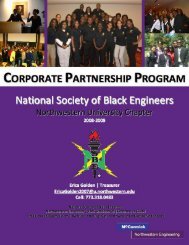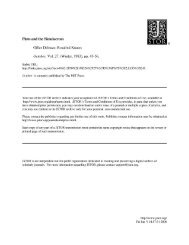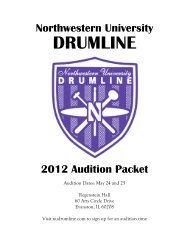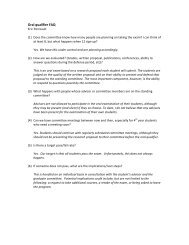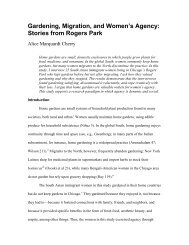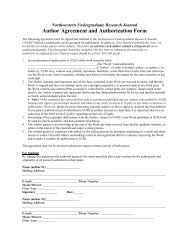RESEARCHstrongly support an umbrella effect in that when the dominant legacy carriers charge higher prices at their hubs,other carriers benefit because they can also charge higher prices without having to worry about losing passengersto cheaper airlines. It should be noted that the findings of an umbrella effect from the legacy carriers do not contradictthe earlier findings of a negative effect of a presence of Southwest on the legacy carriers. That is, a negativeSouthwest effect for legacy carriers does not mean that Southwest has to charge lower prices on these routes than onSouthwest’s other routes in its network. Southwest simply has to charge prices lower than those of the legacy carriers.Thus, Southwest can have a negative effect on the pricing power of legacy carriers while still benefiting from an umbrellaeffect from the legacy carriers’ patterns of charging higher prices on their hub routes.Table 3 covers empirical results generated from a separate set of regressions containing a dummy variable foreach legacy carrier hub airport (Equation 3). Statistics reported in the table could bring more clarity as to what specificairports might be most responsible for the behavior of each legacy carrier’s dummy variable. Based on the table,Southwest seemed to extract large premiums from Dallas (14.8%), Detroit (9.4%), and Houston Hobby (8.7%) in2000. The premium of Detroit matches that of the Northwest dummy listed in Table 3 for the previous regressionbecause Detroit was the only Northwest hub at which Southwest had operations in 2000. Since Dallas (DAL) is closeto Dallas Fort-Worth, an American hub, and Houston Hobby (HOU) is near Houston International (IAH), a Continentalhub, the premiums found at the two Southwest airports can help explain the statistical significance of theAmerican and Continental dummy variables.There are some notable changes from 2000 to 2010. First, Southwest’s hub premium has decreased by more thanhalf to 3.5%. Another change that stands out and could possibly explain the noted decrease in Southwest’s hub premiumis the increased significance of lowcost2. Empirical results in both Tables 2 and 3 indicate that a higher presenceof other low-cost carriers had an impact of -4% on Southwest’s prices by 2010, a sharp contrast to the variable’spositive effect for 2000 as shown in Table 4 when it was significant at the 5% significance level. Although Southwesthas been the most attention-grabbing low-cost carrier with its stable success and rapid expansion, it is certainly notthe only low-cost carrier that has been expanding. Thus, Southwest is sure to have seen increased competition atairports at which it once enjoyed more dominance. Finally, the potential umbrella effects experienced by Southwesthave also gone through some changes over the same time period. An umbrella effect from American Airlines hasdisappeared while a premium at Delta hubs of 6.5% has developed. This, however, could be the result of the Deltaand Northwest merger since Northwest was demonstrating an umbrella effect for Southwest in 2000. The effect fromContinental decreased slightly while there still does not seem to be any effect at United’s hubs. Southwest did notoperate at or near any US Airways hubs in 2000 but new operations at Philadelphia and the development of a USAirways hub at Phoenix have not generated any benefit for Southwest in terms of its ability to charge premiums atthese airports. In fact, the regression with the airport dummies shows that there is no significant pricing differencefor Southwest’s flights to or from Phoenix or Philadelphia.A significant price premium of 4% has developed at Chicago-Midway. However, a premium for Southwestwithin American’s hub network seems to have disappeared due to a hub discount of -4.8% at Fort Lauderdale, whichis near American’s Miami hub. Furthermore, Southwest lost a significant premium at Dallas, which was its mostimportant premium-driving airport in 2000. The development of a premium within Delta’s hub network does seemdue in most part to the merger of Delta with Northwest as Detroit continues to show signs of a premium (6.2%) andnewly expanded operations in Minneapolis (MSP) from the Delta-Northwest merger have given Southwest its largestpremium among legacy hub airports for 2010 at 11.2%.It is interesting that Southwest has not been able to charge a premium to its passengers with origin or destinationat or near one of United’s airports. By 2010, Southwest had operations at or near all of United’s hub airports. Recallingearlier results that the effect of Southwest on United’s prices decreased from 2000 to 2010, the lack of an umbrellaeffect from United is a bit puzzling. One plausible explanation is fiercer competition between the two airlines, whichwould force both parties to charge lower fares at United’s hubs than for flights of similar length in their own networks.Another possible justification could be the baggage fees that the legacy airlines started to charge during thepast couple of years. Baggage fees effectively increase the price of travel with a legacy carrier. The higher price, however,is not reflected in the ticket price in the data. Unlike the legacy carriers, Southwest continues to allow passengersto check in two bags for free. Thus, by 2010, the disparity in baggage fees may make fare comparisons difficultand could lead to misleading results.IV. ConclusionThis study, in its attempt to add on to <strong>research</strong> on hub premiums, examines possible effects of Southwest Airlineson the hub premiums extracted by the legacy carriers. This <strong>research</strong> also explores Southwest’s pricing practices to seeif it is able to charge a hub premium of its own and if it benefits from the hub operations of the legacy carriers.While empirical results show that the hub premium has decreased for all of the legacy carriers, the decreases can-36 NORTHWESTERN UNDERGRADUATE RESEARCH JOURNAL
RESEARCHnot be clearly attributed to an increased presence of Southwest. The changes for American and Delta were closest towhat was expected. From 2000 to 2010, both airlines saw a decrease in their hub premiums that coincided with thedevelopment of a negative Southwest effect. Results for Continental, US Airways, and United do not support thesame intuition. Most puzzling, however, is the lessening adverse effect of Southwest on United even though Southwestwas in close competition with United, particularly at Denver and Los Angeles, by 2010.Perhaps the most intriguing findings are the pricing practices adopted by Southwest within the hub networks ofthe legacy carriers. The results show that Southwest demonstrated a hub premium of its own for both years. However,as with the legacy carriers, Southwest’s hub premium has decreased from 2000 to 2010, which may be due toan increased presence of other low-cost carriers since the lowcost2 variable gained significance during the same timeperiod. Furthermore, Southwest is able to benefit from an umbrella effect from at least some of the legacy carriers,more so in 2000 than in 2010. Positive public perception about Southwest Airlines resides on its tendency to offerprices lower than those of the legacy carriers. However, this does not mean that Southwest cannot or does not chargehigher prices at the legacy carrier hubs relative to other flights in Southwest’s network. That is, Southwest can undercutthe legacy carriers while still offering higher prices of its own.Southwest’s current image seems to be that of a knight sweeping in to save consumers from price gauging habitsof the legacy carriers. Southwest’s expansion in the airline industry has undoubtedly affected all the legacy carriers bybringing competition to their dominant markets. However, the effect does not appear to be uniform across the carriers.In addition, Southwest seems to also be absorbing consumer surplus by charging higher fares both at its largerairports and within the legacy carrier hub networks. Part of Southwest’s tendency to raise its ticket prices relative tothe legacy carriers’ prices doubtlessly reflects the willingness of customers to pay a premium to fly Southwest to takeadvantage of its free baggage service. Extending this study of the relationships between Southwest and the remaininglegacy carriers and the driving forces of airline hub premiums with the application of more sophisticated econometricmethods, especially by addressing potential endogeneity of explanatory variables, serves as a future <strong>research</strong>topic, one that should bring additional clarity to the pricing strategies of major airlines.ReferencesBerry, S., M. Carnall, and P. T. Spiller. “Airline Hubs: Costs, Markups, and the Implications of Customer Heterogeneity.” NBER Working Paper Series, 1996.Borenstein, S. “Hubs and High Fares: Airport Dominance and Market Power in the U.S. Airline Industry.” RAND Journal of Economics 20, no. 3 (1989): 344-65.Gordon, R.J. and D. Jenkins. “Hub and Network Pricing in the Northwest Airlines Domestic System,” <strong>Northwestern</strong> <strong>University</strong> (1999). http://faculty-web.at.northwestern.edu/economics/gordon/gordon_jenkins_1.pdfLederman, M. “Are Frequent Flyer Programs a Cause of the ‘Hub Premium’?” Journal of Economics and Management Strategy 17, no. 1 (2008): 35-66.Lee, D. and M.J. Luengo-Prado. “The Impact of Passenger Mix on Reported ‘Hub Premiums’ in the U.S. Airline Industry.” Southern Economic Journal 72, no. 2 (2005): 372-394.U.S. Department of Transportation. Dominated Hub Fares. Domestic Aviation Competition Series. Office of the Assistant Secretary for Aviation and International Affairs, Washington, DC, 2001.AcknowledgmentsI would like to express my sincere gratitude to my advisors, Dr. Robert Gordon, for his time, invaluable insights,and patience, and Dr. Steffen Habermalz, for his encouragement and guidance throughout my <strong>research</strong> and writingprocess. My thanks also go to Data Base Products, Inc. for its generosity in providing me the <strong>research</strong> data freeof charge. I could not have proceeded with my thesis without the data. Most importantly, I would like to thank myfamily for their unyielding support.VOLUME 7, 2011-2012NORTHWESTERN UNDERGRADUATE RESEARCH JOURNAL37



